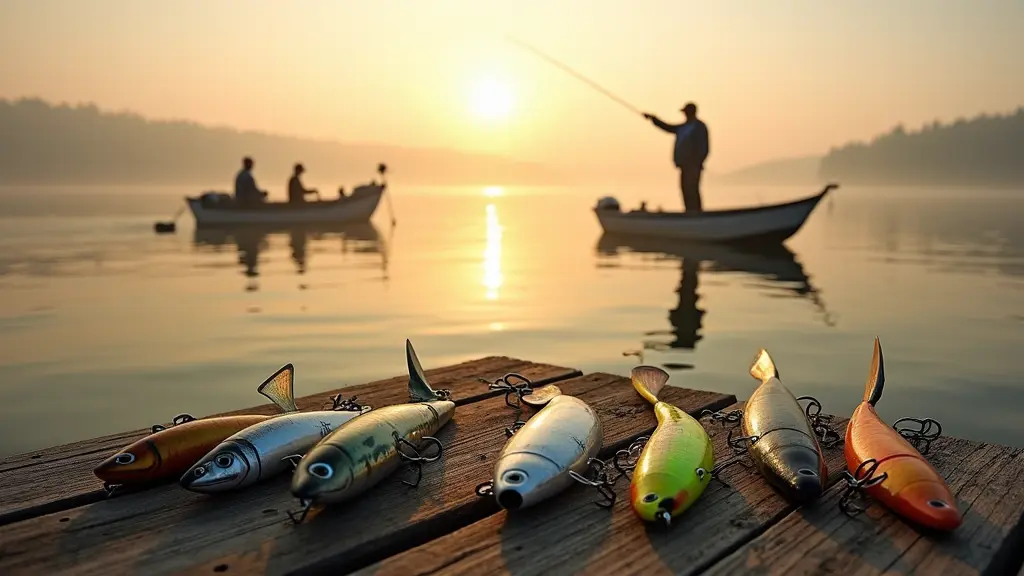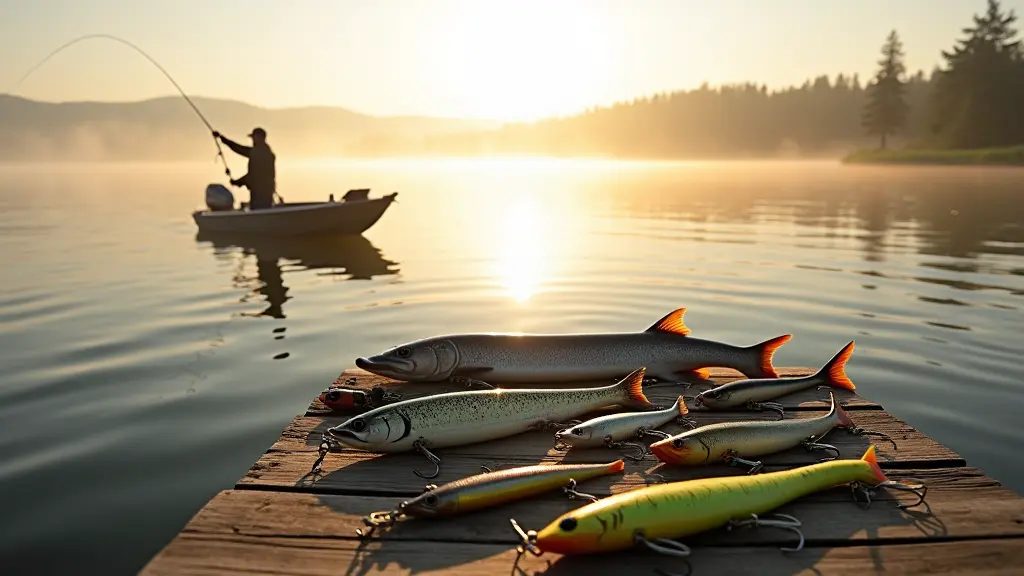Muskie Lures and Techniques

The thrill of battling a monster fish is what drives many anglers to take on the challenge of catching a Muskie. In the Midwest, where these sleek predators roam, the odds of success are often stacked against even the most seasoned fishermen.
To catch a Muskie, it’s essential to understand their behavior and habitat.
These fish are notorious for their finicky nature, making them notoriously hard to catch.
By studying their habits and habitats, anglers can increase their chances of landing a trophy Muskie.
Lure selection is a critical factor in a Muskie’s ability to detect and devour a synthetic meal. Muskie lures have evolved to mimic the appearance and movement of their prey, with crankbaits, jerk.
Finesse Muskie Lures Explained
When pursuing the elusive muskie, anglers must adopt a subtle approach, relying on lures that tease and tempt with calculated precision. While a traditional muskie fishing strategy often involves using aggressive tactics, finesse fishing demands a more nuanced approach, where the goal is to create a tantalizing presentation that triggers a strike.
When setting the stage for finesse muskie lures, it’s essential to understand the techniques and strategies involved.
This means mastering slow and deliberate movements, strategic use of pause and repeat techniques, and a deep understanding of lure action and resonance.
Effective retrieval patterns play a crucial role in finesse fishing. Slow and deliberate movements can create tantalizing presentations that elicit strikes from even the most finicky predators.
By varying retrieval speeds and pausing to let the lure settle, anglers can entice muskie into striking.

What Midwest Fishing Techniques Work Best
The Midwest’s diverse aquatic ecosystem is a paradise for anglers, with its serpentine streams, glassy lakes, and meandering rivers providing a thrilling backdrop for a perfect catch.
Lure Selection Strategies for Midwest Fishing.
Understanding fish behavior and habitat is crucial for effective lure selection.
Key factors to consider include the size, color, action, and scent of your lure.
For instance, during dawn and dusk, slow-moving lures tend to outperform others due to their ability to mimic the natural movement of jigs.
Crankbait Trout Bites.
Crankbaits are a popular choice among anglers due to their versatility and ability to target suspended fish. By offering a range of depth settings and spinners, crankbaits can be used to imitate the natural movement of baitfish, making them a versatile and effective fishing lure.
Lure Selection Strategies for Midwest Fishing
- The Midwest’s diverse aquatic ecosystem provides a thrilling backdrop for a perfect catch, with serpentine streams, glassy lakes, and meandering rivers.
- Understanding fish behavior and habitat is crucial for effective lure selection, considering factors such as size, color, action, and scent of your lure.
- Crankbaits are a popular choice among anglers due to their versatility and ability to target suspended fish, offering a range of depth settings and spinners.
- Slow-moving lures tend to outperform others during dawn and dusk, mimicking the natural movement of jigs and attracting fish.
Lure Selection for Elusive Muskie
As the morning mist lifts, the thrill of the chase for the legendary largemouth bass-like fish, muskie, awakens. With their notorious reputation for being one of the most elusive and challenging species to catch, it’s no surprise that anglers meticulously seek out the perfect lure to entice these fish.
Understanding Muskie Behavior
Before selecting the right lure, it’s essential to understand the behavior of muskies.
They inhabit a variety of habitats, including rocky structures, weed beds, and sunken logs.
They are ambush predators, using their acute sense of smell and exceptional eyesight to detect prey.
Choosing the Right Retrieval Speed
Retrieval speed is a crucial factor in lure selection.
Fast retrieval can trigger aggressive strikes, while slow retrieval can induce subtle bites. Anglers must adapt their retrieval speed to Mino Rig presentations, as the finicky muskie often demands a subtle, delayed strike.
Fishing Tactics for Success
As the sun rises over the tranquil waters, the thrill of the hunt begins, and anglers armed with the right strategies can’t help but feel a sense of excitement and anticipation.
Fishing for Success: Mastering the Art of Lure Selection
When it comes to muskie fishing, selecting the right lure is crucial.
The key is to understand the behavior and preferences of the muskie and choose a lure that mimics its natural prey.
For instance, using Siren Lures that mimic the sound of injured baitfish can be particularly effective.
The art of lure selection involves understanding the muskie’s natural feeding habits and choosing lures that cater to its preferences. This could involve employing BuckShot Rattle lures that produce a loud, rattling sound to attract the muskie’s attention. Alternatively, a TailShot Rattle lure might be used to create a commotion.
Facts About Muskie Fishing
- Muskie prefer lures that mimic their natural prey.
- Siren Lures that mimic the sound of injured baitfish can be particularly effective.
- BuckShot Rattle lures produce a loud, rattling sound to attract muskie attention.
- TailShot Rattle lures can create a commotion to attract muskie.
How to Choose Fishing Gear
The thrill of landing a big catch is closely tied to the satisfaction of having the right gear in your hands. For many anglers, the journey to the perfect fishing spot is just as enjoyable as the catch itself.
Fishing styles vary, and understanding yours is crucial in choosing the right gear.
For example, if you’re a fan of fly fishing, you’ll need to invest in a suitable rod, reel, and line combination.
Understanding Your Fishing Style
Before selecting gear, identify the type of fishing you’ll be doing – casting, trolling, or fly fishing. Consider the environment and water conditions you’ll be fishing in, as well as the type of fish you’re targeting.
When selecting lures, examine the action and movement of different options, such as diving crankbaits that mimic injured fish, crankbait triggers that imitate the vibrations of baitfish, soft hackle jigs that resemble a worm or crawdad, hair jigs that appear as a injured baitfish, umbrella rigs that mimic a school of shad, stink baits that emit a strong odor, lure retrievers that change the retrieval speed, and lure actions that vary the retrieve technique.
What Baits Muskie prefer
Muskies are notoriously finicky predators, and understanding their unique preferences is crucial for a successful fishing trip. In the world of muskie fishing, the right bait can make all the difference between a day filled with excitement and one that’s a complete blank.
When it comes to visual appeal, muskies are attracted to shiny, reflective surfaces that catch their attention.
Fishing in sunny weather, with a high-contrast retrieval method, can help them spot the lure more easily.
Vibrant colors like red, orange, and yellow also play a crucial role in enticing these fish, as they are naturally drawn to shiny and bright objects.
Structure such as weed beds and rock piles can be particularly effective for catching them.
To create movement and action, sudden, erratic movements and quick changes in direction can be very effective. Long, winding retrieves are often successful based on retrieval methods, fishing conditions, weather, water conditions, structure, cover, habitat, fishing strategies, and fishing styles.
Muskie Fishing
- Muskies are attracted to shiny, reflective surfaces that catch their attention.
- Vibrant colors like red, orange, and yellow are crucial for enticing muskies.
- Sudden, erratic movements and quick changes in direction can create movement and action.
- Long, winding retrieves can be successful based on retrieval methods, fishing conditions, and structure.
Can You Catch Muskie in River
Elusive Fishing can be a thrilling adventure, and few species embody this spirit as well as the mighty Muskie. The thrill of reeling in a fierce predator from the depths of a winding river is a sensation unlike any other, and for many anglers, the allure of catching a Muskie in river waters is a challenge that is both exhilarating and elusive.
The Muskie species is perfectly adapted to thrive in river habitats, growing up to 50 inches in length and weighing up to 50 pounds, making them one of the largest and most powerful fish in North America.
Their aggressive nature and strong fighting ability make them a prized catch, while their diverse habitat preferences require anglers to develop a deep understanding of river conditions and strategies to successfully target them. Characterized by their ability to thrive in river structure, Muskie require a deep understanding of fishing techniques such as bait selection, baitfish patterns, and pike fishing techniques learned through experience in lake fishing and river fishing.
How to Use Sinkers Effectively
When it comes to landing the big catch, the right tackle can make all the difference. Pike Fishing Gear plays a crucial role in this, and one often overlooked aspect is the effective use of sinkers.
Mastering the art of sinkers requires a thorough understanding of the factors that affect their performance, including water conditions, fish behavior, and lure type.
Choosing the right sinkers is crucial for a successful fishing trip.
This involves considering the water conditions you’ll be fishing in, such as current, temperature, and depth. For example, a sinker that works well in calm water may not be effective in strong currents.
Proper rigging and presentation are also essential when using sinkers. This includes carefully placing the sinker on the line and orienting the lure correctly. Failure to do so can result in a poorly presented lure that fails to effectively attract pike.
Pike Fishing
- Water conditions, fish behavior, and lure type affect the performance of sinkers.
- The right sinker can make all the difference in landing the big catch.
- Proper rigging and presentation are essential when using sinkers to attract pike.
- Sinkers that work well in calm water may not be effective in strong currents.


